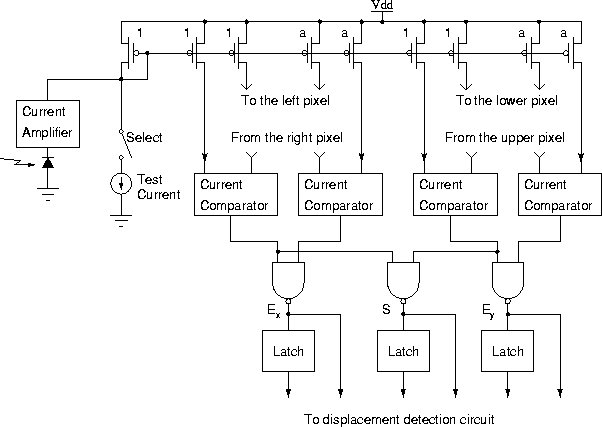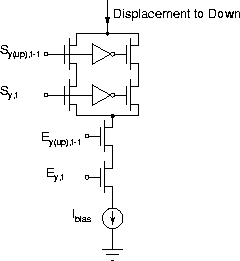This chip, is the first commercial motion detection chip designed for use in computer mice [Arreguit et al. 96a, Arreguit et al. 96b]. Its success is achieved by several simplifying conditions, such as controlling the illumination range, using a binary B&W image with sharp contrast, minimizing the use of analog circuits to basic building blocks, and performing the tasks of motion detection and displacement measurement using 1-bit digital circuits.
The chip in fact detects the global displacement of the image, which
is a pattern of dots with random size and position. The block diagram
of the pixel circuit is shown in Figure 3.40. The
chip first finds the edges ( ![]() and
and ![]() ) and the sign of the
gradient of the edges (S) in the horizontal and vertical direction.
As the patterns are binary, edges and the gradient signs detected by
simply comparing the output photocurrents of two neighboring cells.
In order to reduce the effect of mismatch and noise two comparisons
involving the factor a (which is 2 in this hardware
implementation) are performed.
) and the sign of the
gradient of the edges (S) in the horizontal and vertical direction.
As the patterns are binary, edges and the gradient signs detected by
simply comparing the output photocurrents of two neighboring cells.
In order to reduce the effect of mismatch and noise two comparisons
involving the factor a (which is 2 in this hardware
implementation) are performed.

where ![]() and
and ![]() indicate the presence of an edge in the vertical
and horozontal directions, respectively, when they are ``0''. S is
the sign of the gradient. Note that it has a mixture of both x
and y components. If fact S is only used as a simple
cofidence measure to avoid spati-temporal aliasing from small size
patterns, or very fast movements.
indicate the presence of an edge in the vertical
and horozontal directions, respectively, when they are ``0''. S is
the sign of the gradient. Note that it has a mixture of both x
and y components. If fact S is only used as a simple
cofidence measure to avoid spati-temporal aliasing from small size
patterns, or very fast movements.
The chip then uses the present and previous values of the edge and gradient to detect whether there has been a displacement in either of the four directions. The circuit used for finding the downward displacement is shown in Figure 3.41. Similar circuits are used for other directions.
The output currents of all pixels associated with each direction are summed. An on-chip ADC and some other analog circuits find the global displacement in the x and y directions. The chip also comprises some other digital control and interface circuits for connection to a standard serial port.
The fabricated chip contains 93 photodiodes and 75 pixels of
processing elements. In has been fabricated in a 2 ![]() m low power,
low-voltage CMOS process, in an area of 4.4
m low power,
low-voltage CMOS process, in an area of 4.4 ![]() 4.3
4.3 ![]() .
.

Figure 3.40: Block diagram of the pixel circuit.

Figure 3.41: Displacement detection circuit for the downward direction.